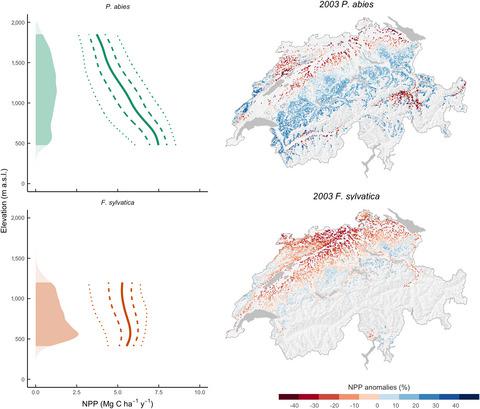当前位置:
X-MOL 学术
›
Glob. Change Biol.
›
论文详情
Our official English website, www.x-mol.net, welcomes your
feedback! (Note: you will need to create a separate account there.)
Assessing the response of forest productivity to climate extremes in Switzerland using model-data fusion.
Global Change Biology ( IF 10.8 ) Pub Date : 2020-01-22 , DOI: 10.1111/gcb.15011 Volodymyr Trotsiuk 1, 2, 3, 4 , Florian Hartig 5 , Maxime Cailleret 2, 3, 6 , Flurin Babst 2, 7 , David I Forrester 2, 3 , Andri Baltensweiler 2 , Nina Buchmann 1, 3 , Harald Bugmann 3, 8 , Arthur Gessler 2, 3, 8 , Mana Gharun 1 , Francesco Minunno 9 , Andreas Rigling 2, 3, 8 , Brigitte Rohner 2, 3 , Jonas Stillhard 2 , Esther Thürig 2, 3 , Peter Waldner 2, 3 , Marco Ferretti 2, 3 , Werner Eugster 1, 3 , Marcus Schaub 2, 3
Global Change Biology ( IF 10.8 ) Pub Date : 2020-01-22 , DOI: 10.1111/gcb.15011 Volodymyr Trotsiuk 1, 2, 3, 4 , Florian Hartig 5 , Maxime Cailleret 2, 3, 6 , Flurin Babst 2, 7 , David I Forrester 2, 3 , Andri Baltensweiler 2 , Nina Buchmann 1, 3 , Harald Bugmann 3, 8 , Arthur Gessler 2, 3, 8 , Mana Gharun 1 , Francesco Minunno 9 , Andreas Rigling 2, 3, 8 , Brigitte Rohner 2, 3 , Jonas Stillhard 2 , Esther Thürig 2, 3 , Peter Waldner 2, 3 , Marco Ferretti 2, 3 , Werner Eugster 1, 3 , Marcus Schaub 2, 3
Affiliation

|
The response of forest productivity to climate extremes strongly depends on ambient environmental and site conditions. To better understand these relationships at a regional scale, we used nearly 800 observation years from 271 permanent long-term forest monitoring plots across Switzerland, obtained between 1980 and 2017. We assimilated these data into the 3-PG forest ecosystem model using Bayesian inference, reducing the bias of model predictions from 14% to 5% for forest stem carbon stocks and from 45% to 9% for stem carbon stock changes. We then estimated the productivity of forests dominated by Picea abies and Fagus sylvatica for the period of 1960-2018, and tested for productivity shifts in response to climate along elevational gradient and in extreme years. Simulated net primary productivity (NPP) decreased with elevation (2.86 ± 0.006 Mg C ha-1 year-1 km-1 for P. abies and 0.93 ± 0.010 Mg C ha-1 year-1 km-1 for F. sylvatica). During warm-dry extremes, simulated NPP for both species increased at higher and decreased at lower elevations, with reductions in NPP of more than 25% for up to 21% of the potential species distribution range in Switzerland. Reduced plant water availability had a stronger effect on NPP than temperature during warm-dry extremes. Importantly, cold-dry extremes had negative impacts on regional forest NPP comparable to warm-dry extremes. Overall, our calibrated model suggests that the response of forest productivity to climate extremes is more complex than simple shift toward higher elevation. Such robust estimates of NPP are key for increasing our understanding of forests ecosystems carbon dynamics under climate extremes.
中文翻译:

使用模型数据融合评估瑞士森林生产力对极端气候的响应。
森林生产力对极端气候的反应在很大程度上取决于周围环境和场地条件。为了更好地了解区域范围内的这些关系,我们使用了 1980 年至 2017 年间从瑞士 271 个永久长期森林监测地块获得的近 800 个观测年的数据。我们使用贝叶斯推理将这些数据同化到 3-PG 森林生态系统模型中,将森林茎碳储量模型预测的偏差从 14% 降低到 5%,将茎碳储量变化的模型预测偏差从 45% 降低到 9%。然后,我们估算了 1960 年至 2018 年期间以云杉和水青冈为主的森林的生产力,并测试了生产力随海拔梯度和极端年份气候的变化。模拟净初级生产力(NPP)随海拔升高而降低(冷杉为 2.86 ± 0.006 Mg C ha-1year-1 km-1,F. sylvatica 为 0.93 ± 0.010 Mg C ha-1year-1 km-1)。在温暖干燥的极端情况下,这两个物种的模拟 NPP 在较高海拔处增加,在较低海拔处减少,瑞士潜在物种分布范围的 NPP 减少了 25% 以上,高达 21%。在暖干极端时期,植物可用水量的减少对 NPP 的影响比温度的影响更大。重要的是,与暖干极端事件相比,干冷极端事件对区域森林NPP的负面影响相当。总体而言,我们的校准模型表明,森林生产力对极端气候的反应比简单地向更高海拔的转变更为复杂。对 NPP 的这种稳健估计对于增进我们对极端气候下森林生态系统碳动态的了解至关重要。
更新日期:2020-02-18
中文翻译:

使用模型数据融合评估瑞士森林生产力对极端气候的响应。
森林生产力对极端气候的反应在很大程度上取决于周围环境和场地条件。为了更好地了解区域范围内的这些关系,我们使用了 1980 年至 2017 年间从瑞士 271 个永久长期森林监测地块获得的近 800 个观测年的数据。我们使用贝叶斯推理将这些数据同化到 3-PG 森林生态系统模型中,将森林茎碳储量模型预测的偏差从 14% 降低到 5%,将茎碳储量变化的模型预测偏差从 45% 降低到 9%。然后,我们估算了 1960 年至 2018 年期间以云杉和水青冈为主的森林的生产力,并测试了生产力随海拔梯度和极端年份气候的变化。模拟净初级生产力(NPP)随海拔升高而降低(冷杉为 2.86 ± 0.006 Mg C ha-1year-1 km-1,F. sylvatica 为 0.93 ± 0.010 Mg C ha-1year-1 km-1)。在温暖干燥的极端情况下,这两个物种的模拟 NPP 在较高海拔处增加,在较低海拔处减少,瑞士潜在物种分布范围的 NPP 减少了 25% 以上,高达 21%。在暖干极端时期,植物可用水量的减少对 NPP 的影响比温度的影响更大。重要的是,与暖干极端事件相比,干冷极端事件对区域森林NPP的负面影响相当。总体而言,我们的校准模型表明,森林生产力对极端气候的反应比简单地向更高海拔的转变更为复杂。对 NPP 的这种稳健估计对于增进我们对极端气候下森林生态系统碳动态的了解至关重要。










































 京公网安备 11010802027423号
京公网安备 11010802027423号